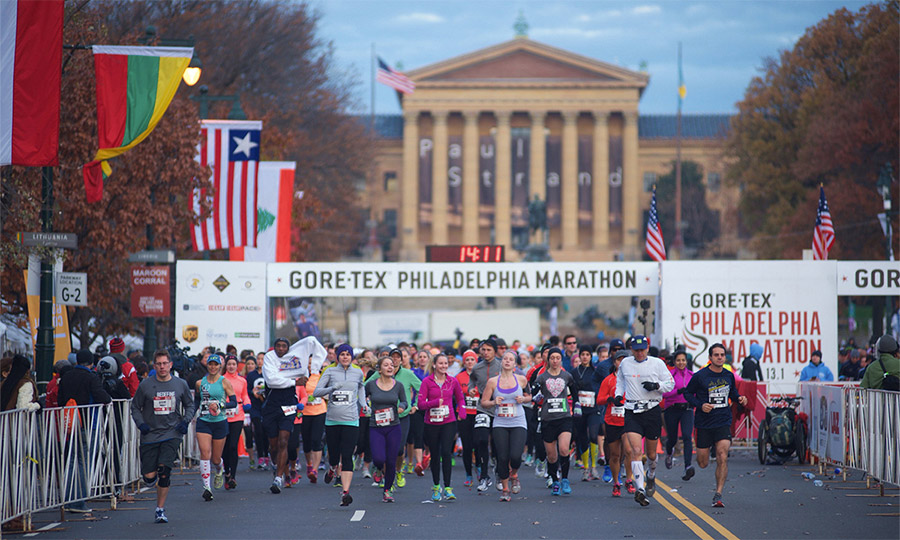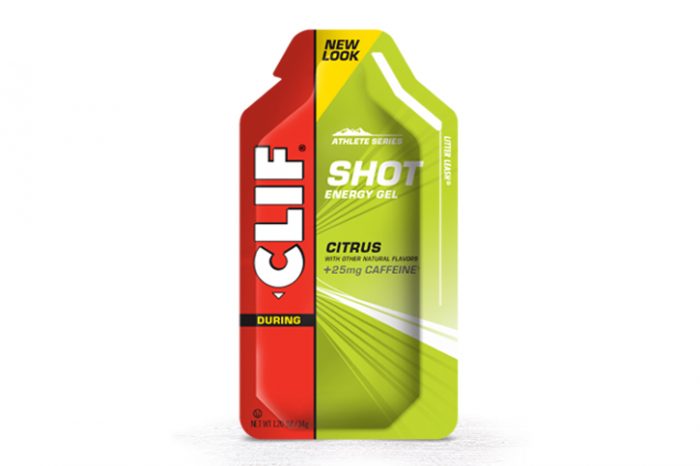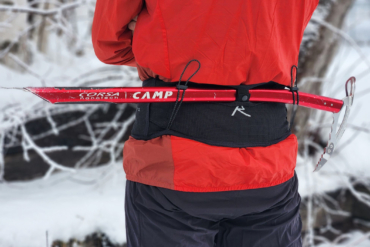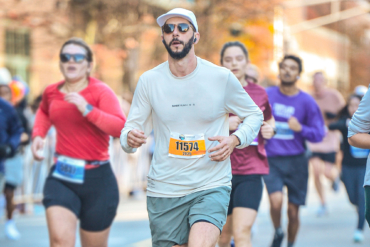Over the past ten years, I’ve signed up for and completed dozens of marathons, including scorchers where the sun beat down and the air was nearly 100 degrees to mild days running under clouds.
On these races, I’ve suffered from dehydration, heat exhaustion, blisters, sun burn, sore joints, cramps, pulled muscles, black toenails, and other maladies.
Here are a dozen personal tips — some unorthodox, take them or leave them — on products and techniques that have helped me make it from the start line, through 26.2 miles, and on to the end.
Editor’s Note: This article was originally published in 2008; here we update it for 2017.
1. Wear Big Shoes
I wear shoes about 1/2 to one full size too large when I run. You can lace them tight enough to always feel like they fit fine. But the larger size allows your toes ample room to spread out and breathe. Your feet will swell after many miles on the run, so the extra room is needed.

2. Lube The Feet
If your feet are in pain, you will run slower. You may even quit the race. Over the years, I’ve suffered through dozens of blisters and black toenails. To combat foot troubles, I employ a foot lubricant called Hydropel. Smear it across your toes and glop it on your heel. Pull a sock over it all, your foot feeling gooey inside. This will keep your skin from bunching up and blistering. It works.
3. Tape Hot Spots
Bring a small amount of duct tape or medical Leukotape along on the marathon. The moment you feel a hot spot developing on your foot, stop and apply the tape as a layer of protection. Put it on tight and smooth so as not to add bulk or cause another spot of friction. This is not a medical treatment, but it will keep the blister from getting worse.
4. Ibuprofen
This “performance-enhancing drug” is not outlawed by any board. It can help with temporary pain.
(Editor’s note: Some medical studies link the ingestion of nonsteroidal anti-inflammatory drugs (NSAIDs) such as ibuprofen (Advil), aspirin, and naproxen sodium (Aleve) during athletics to gastrointestinal issues and poor fluid transport in the body, which may lead to an increased risk of hyponatremia, dehydration, and at the extreme, kidney failure. Consult with a doctor before taking drugs for any event.)
5. Drink
Most marathons feature hydration tables every couple miles. On a hot day, I grab a water and/or a sports drink at every single one. Even just a quick sip or half a glass will be enough.

6. Eat
Any general marathon advice manual will stress staying hydrated. But consuming calories is almost important for success. I find that consuming 100 or more calories an hour keeps me energized and fast. Athletic gels are the preferred food for most endurance athletes. I squeeze one down every 45 minutes or so as I run.
7. Tummy Medicine
But. . . if you eat too much (unlikely) or just have a mal gut while on the run (likely) you might consider packing Tums or another stomach medicine along. I usually stow some tummy pills in my shorts pocket for crunching on the run if things start to grumble down below.
8. ‘Salt’ Pills
Swallow an electrolyte tablet — sometimes called salt pills — and you’re downing the equivalent of a small glass of Gatorade. That’s the simplified way to explain it. But pills like Endurolytes from Hammer Nutrition ($17 for 120 pills) have helped me on races to stay cramp-free.
9. Body Lube
Beyond lube for my feet (see above), I always slather some kind of lubricant under my arms and in my shorts. These natural hot spots, where arms swish repeatedly for hours and legs rub together, are potential places of pain. Avoid a bad rub by coating your skin with a thick layer of lube.
10. Sunscreen
You will bake running on the pavement for 26.2 miles. Make sure to wear sunscreen not just on your neck, arms and face, but also your legs. Some races I’ve been burned badly on my calves and thighs by errant sunshine bouncing off cement and city streets for hours.
11. Heart Rate Monitor
I religiously employ a heart-rate monitor while running to provide an exact, immediate gauge of what my body is doing in comparison to the clock. For my race this year, I started at about a 155 beats-per-minute pace and ran that way for more than half the race. It was a pace I could maintain for two hours, and it allowed me to push my body — but not push it so much that I’d be worn down for the finish.

12. Run The Last Mile
To me, a marathon is a 25-mile race. The final mile and change does not count. By that point in the game the finish line is in sight. People are cheering. You have huge relief that the end is near. Every marathon I’ve done I hit it hard for the last mile. I pound it out, sometimes in great pain, at a pace faster than many of the miles before. Run hard. Get it done. Then flop over the finish line, arms raised in victory at the end. You’ve made it. You are a marathoner!









